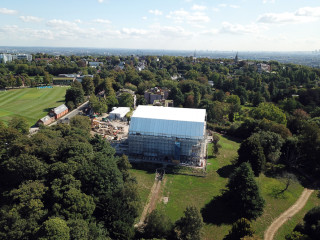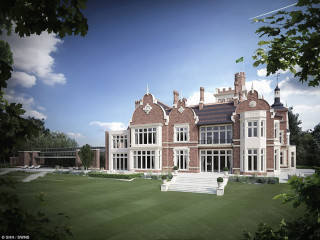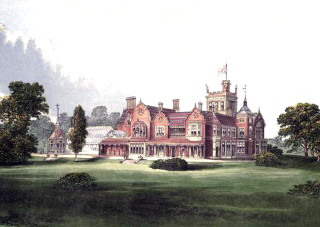Located on the northern edge of Hampstead Heath, Athlone House is a grand residence, built in 1872 by Victorian industrialist Edward Brooke. The house, which sits in an elevated position surrounded by eight acres of landscaped grounds has exceptional views across London.
But it has been many years since Athlone House was used as a private residence. Requisitioned by the government during World War II it served as an RAF training school, later being converted into a geriatric hospital. It remained as an NHS hospital right up until 2003, when it was sold to a firm of investors with an eye to redevelopment.
For the past 16 years the property has sat empty, gradually falling into disrepair. But about three years ago it changed hands once more, bought by Russian billionaire Mikhail Fridman who has resolved to restore and improve the property and return it once again to residential use.
The task of delivering that transformation is the responsibility of contractor Knight Harwood, with a programme of conservation and refurbishment to preserve the existing structure and many of its original features, while adding a number of new features including a media room, wine cellar and underground swimming pool.
The Athlone House project is no small undertaking. The level of disrepair necessitates a programme that includes roofing works, extensive structural repairs, restoration of stonework and brickwork, replacement of perished timbers, damp- proofing and replacement of all windows.
Thankfully the Knight Harwood team has access to a wealth of Victorian plans and images to guide the construction and restoration work. But to do the work, access is required to every inch of the external structure.
This has been provided by south London-based scaffolding specialist Millcroft, which supplied a full package of design, engineering and site services to ensure a safe and stable scaffold capable of withstanding the high wind loadings on the exposed site.
Founded 40 years ago, Millcroft is a specialist in scaffolding for complex and challenging projects in the heritage and conservation sector and employs an in-house design and engineering team experienced in developing bespoke solutions for unique projects.
But Athlone house is more challenging than most. The poor condition of the building and the scope of façade works meant that the scaffolding could not be fixed to any part of the existing house, so a free-standing scaffolding structure had to be designed that would be close enough to the building to allow full access to the façades while remaining completely independent of the structure.
Millcroft director Billy Jones explains: “The façades were in a very poor state of repair and restoration of the stonework was needed across the main building, including painstaking works to bring decorative details back to their former glory.
“For us, this meant the challenge of creating a scaffold that would provide access for all façades at all levels without the use of any fixings to the façade. Because the structure needed to be kept as dry as possible during the works and the roof was so badly damaged, we also needed to factor-in the requirement for a covered scaffold, which is effectively a giant tent fixed to the scaffolding.”
The challenge was therefore two-fold: to create a strong and stable scaffolding structure that was both able to offer safe access to the façades without physically touching them, and to encapsulate this structure in way that could cope with the wind loading both during and after construction of the scaffold.
Millcroft’s first step was to work with the client to understand the requirements for the scaffold to ensure it would meet the needs of the project throughout the programme.
“We have worked with Knight Harwood on a number of projects,” Jones continues, “so they know that our approach is to interrogate the brief and understand what they need to do on site, not just what they want from the scaffolding. In that way we can provide a solution that addresses the buildability challenges of the construction programme.”
With a full understanding of the requirements, the Millcroft team then began the process of designing and engineering the scaffolding, using 3D modelling to understand the effects of the wind and the forces required to keep the scaffolding in place.
Jones continues: “Not only was the wind loading very high due to the elevated and exposed site, but the need to create a covering over the roof meant that we faced the risk of channelling the wind into the covered scaffolding and creating a wind tunnel effect, thereby increasing the impact of the wind forces.
“We had to engineer the scaffolding in such a way that it would remain stable and consider the sequencing of works so that it was safe for our teams to erect the structure,” he adds.
The answer to anchoring the scaffolding to the ground rather than the structure was to use kentledge blocks, or ballast, and the modelling process for the scaffolding included calculating the location and weight of the ballast to ensure that the scaffolding was evenly balanced on all façades.

Two hundred concrete blocks, each weighing 2.5 tonnes, were used in a carefully-sequenced programme of works designed to ensure that the scaffolding was evenly ballasted throughout the build.
Jones continues: “The sequencing of the build was just as critical as the design of the scaffold, both from a health and safety point of view and from the point of view of protecting the structure from damage. This not only included the erection of the scaffold itself and the positioning of the kentledge blocks but also the order in which we put each piece of sheeting in place and even the direction in which we installed the sheeting from one location to the next.”

The initial scaffold structure took 14 weeks to complete, with around 25 experienced scaffolders from Millcroft’s in-house team working on the core scaffold build phase.
“It’s fair to say that we all underestimated the challenge involved,” says Billy, “and I am fairly certain that there has never been a scaffold quite like this. It has relied on close collaboration with the client and across our internal teams, with our team of designers, engineers and advanced scaffolders working together to anticipate the pressure points and tackle the complexities of the structural and wind loading challenges.”
That close collaboration has continued since the project began over a year ago and will remain integral to the success of the project until Millcroft strikes the scaffolding early next year. The Millcroft team that managed the initial scaffolding build has also been responsible for ongoing liaison with Knight Harwood to implement adaptations in line with the construction programme.
Jones explains: “For the main façade scaffolding structure, the temporary covering has had to be pulled back each time a crane load needed to be delivered through the roof and, given the wind loadings, this has had to be carefully managed. Adaptations to the main scaffold have also included changes to accommodate access to brickwork and stonework at different levels.
“Alongside these adaptations, there has been a need for access platforms at different level inside the main building as the refurbishment has progressed along with additional scaffolds to existing outbuildings and a two-storey extension.”
Millcroft supervisors have attended weekly planning and health and safety meetings with the Knight Harwood team on site to ensure that all scaffolding requirements are built into the schedule and changes in access requirements are sequenced to be ready in time for each element of the works.
Knight Harwood director, Ian Harwood, adds: “The unique challenges of this job have required a partnership approach with our scaffolding supplier since the early programme planning stages of the job and that relationship has been critical to keeping the schedule on track throughout the project.
“A flexible, solutions-driven approach with a strong emphasis on health and safety has ensured that the scaffolding has kept pace with our requirements, enabling our team to get on with what they do best.”

Home from home
Designed in a mixture of classical and Dutch styles by Manchester architect Edward Salomons, Athlone House was built in 1872 for industrialist Edward Brooke as his family home for the next 13 years.

After Brooke left, the house (originally called Caen Wood Towers) became home to a succession of rich businessmen: first soap-and-polish magnate Francis Reckitt, then coal merchant Sir Francis Cory-Wright and finally Sir Robert Waley Cohen, managing director of the Shell Company.
Then, in 1942, the property (now renamed Athlone House) was requisitioned by the government and used as an RAF intelligence school. During the war, the house had the misfortune to be hit by not one, but two V1 flying bombs, causing extensive damage.
In 1951 the house was converted into a hospital for geriatric patients and remained in the ownership of the NHS until its closure in 2003.
In 2016, after years of neglect, the house was once more acquired by a rich businessman, this time Russian billionaire Mikhail Fridman, who is reported to have paid £65m for the property and plans to make it his home.
Before Fridman came along, the house had fallen into the ownership of Kuwaiti speculators whose plan to demolish it and build a modern “mega-mansion” on the site was blocked by planners.
Fridman told his local paper, the Ham & High, that he intends to restore Athlone House “to its former glory” and use it as his primary residence.
This article was first published in the March 2019 issue of The Construction Index magazine
UK readers can have their own copy of the magazine, in real paper, posted through their letterbox each month by taking out an annual subscription for just £50 a year. Click for details.
Got a story? Email news@theconstructionindex.co.uk


